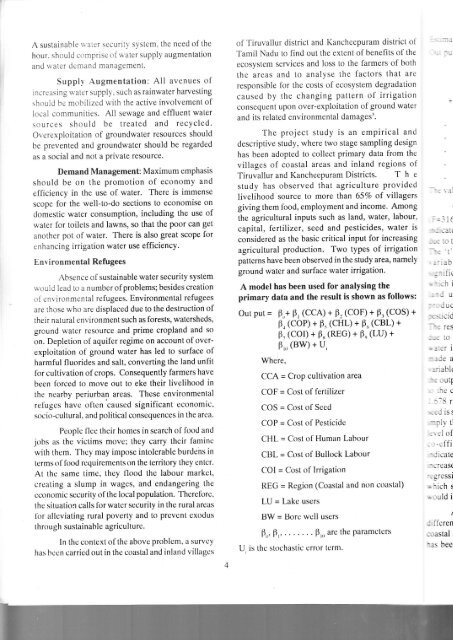Download (4Mb) - Covenant University Repository
Download (4Mb) - Covenant University Repository
Download (4Mb) - Covenant University Repository
You also want an ePaper? Increase the reach of your titles
YUMPU automatically turns print PDFs into web optimized ePapers that Google loves.
A sustainable \l ater securitV system, the need of the<br />
hour. should comprise of rvater supply augmentation<br />
and $'ater demand management.<br />
Suppl.v .{ugmentation: All avenues of<br />
increasing $'ater supply. such as rainwater harvesting<br />
should be mobilized with the active involvement of<br />
local communities. Ail sewage and effluent water<br />
sources should be treated and recycled.<br />
Overexploitation of groundwater resources should<br />
be prevented and groundwater should be regarded<br />
as a social and not a private resource.<br />
Demand Management: Maximum emphasis<br />
shoukl be on the promotion of economy and<br />
efliciency in the use of water. There is immense<br />
scope for the well-to-do sections to economise on<br />
domestic water consumption, including the use of<br />
water for toilets and lawns, so that the poor can get<br />
another pot of water. There is also great scope for<br />
enhancing irrigation water use efficiency.<br />
Environmental Refugees<br />
Absence of sustainable water security system<br />
rr ould lead to a number of problems; besides creation<br />
of environmental refugees. Environmental refugees<br />
are those who are displaced due to the destruction of<br />
their natural environment such as forests, watersheds,<br />
ground water resource and prime cropland and so<br />
on. Depletion of aquifer regime on account of overexploitation<br />
of ground water has led to surface of<br />
harmful fluorides and salt, converting the land unllt<br />
tbr cultivation of crops. Consequently farmers have<br />
been tbrced to move out to eke their livelihood in<br />
the nearby periurban areas. These environmental<br />
re{uges have often caused significant economic,<br />
socio-cullural, and political consequences in the arca.<br />
People llee their homes in search ol food and<br />
jobs as the victims move; they carry their laminc<br />
with them. Thcy may impose intolerable burdens in<br />
terms of lbod requirements tln the territory they enter.<br />
At the same time, they flood thc labour markcl,<br />
creating a slump in wages, and endangering the<br />
cconomic sccurity of the local population. Therelbrc,<br />
the situation calls lbr watcr security in the rural areas<br />
lbr alleviating rural poverty and to prevent exodus<br />
through sustainable agriculture.<br />
ln the context of thc abovc problem, a survcy<br />
has hecn carried out in the coastal and inland villagcs<br />
ol Tiruvallur district and Kancheepuram district ol<br />
Tamil Nadu to llnd out the extent of benefits of the<br />
ecosystem services and loss to the farmers of both<br />
the areas and to analyse the factors that are<br />
responsible lbr the costs of ecosystem degradation<br />
caused by the changing pattern of irrigation<br />
consequent upon over-exploitation of ground water<br />
and its related environmental damagesr.<br />
The project study is an empirical and<br />
descriptive study, where two stage sampling design<br />
has been adopted to collect primary data from the<br />
villages of coastal areas and inland regions of<br />
Tiruvallur and Kancheepuram Districts. T h e<br />
study has observed that agriculture provided<br />
livelihood source to more than 65Vo of villagers<br />
giving them food, employment and income. Among<br />
the agricultural inputs such as land, water, labour,<br />
capital, fertilizer, seed and pesticides, water is<br />
considered as the basic critical input for increasing<br />
agricultural production. Two types of irrigation<br />
patterns have been observed in the study area, namely<br />
ground water and surface water irrigation.<br />
A model has been used for analysing the<br />
primary data and the result is shown as follows:<br />
Oul put = 0,,+ gr (CCA) + p, (COF) + p. (COS) +<br />
P, (CoP) + P. (cHL) + $, (cBL) +<br />
p, (COI) + P- (REG) + P, (LU) +<br />
B"' (BW) + u<br />
Where.<br />
CCA = Crop cultivation area<br />
COF = Cost of fertilizer<br />
COS = Cost of Seed<br />
COP = Cost of Pesticide<br />
CHL = Cost of Human Labour<br />
CBL = Cost of Bullock Labour<br />
COI = Cost of Irrigation<br />
REG = Region (Coastal and non coastal)<br />
LU = Lakc users<br />
IJW = lJore wcll users<br />
F,n P,, ' 0,,, arc the Paramctcrs<br />
U is thc skrchastic crror tcrnt.<br />
'":"3]<br />
:=:1(<br />
-:rJaI(<br />
--: -tl L<br />
:t<br />
.:lab<br />
:- rfic<br />
, -.:h i<br />
- i ,.<br />
-r U<br />
:-:duc<br />
: :,JCid<br />
',:<br />
t: rgs<br />
: i Ifc ren<br />
:oaslal<br />
'as bee
















